TREE LIFE
AUGUST 2023
Hi Everyone,
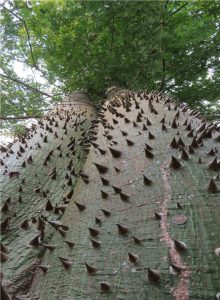
A contribution from Zanzibar
Unfortunately this will be my last issue of Tree Life, I am just a bit overwhelmed in the work and personal life sphere in the current environment. I wish the new Editor, the very best and undoubtedly, I’ll contribute something from time to time to Tree Life going forward. Part of the content in this edition is about a trip we recently undertook to Zanzibar, and it is a fascinating place indeed.
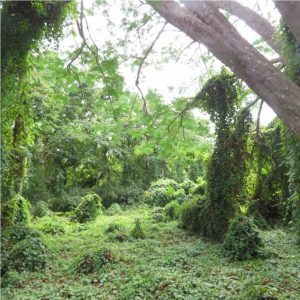
A contribution from Zanzibar
However most of the trees you see around the settlements are alien and although there is natural vegetation, especially on the coral rocky coastlines, the shrubbery grows so dense that you probably would not advance even 5 metres into it. And if you did advance further, you might never break free!
Cheers, Rob Jarvis, (Former) Editor
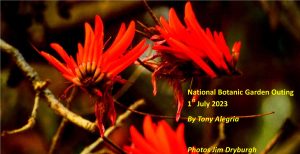
As of late, the day began with clear skies, cold in the shade and warm in the sun. However, it did warm up nicely and became rather pleasant. Attending were the ladies: Meg Coates Palgrave, Dawn Siemers, Mary Toet and Ann Sinclair and the men: Mark Hyde, Jim Dryburgh, Sean Lightfoot and me. Later on we were joined by a young black man – Tony.
The mission for the day was to look at trees that had bifoliolate or trifoliolate leaves. It is to be noted that there are very few trees that only have two leaflets and these were represented in the garden by: Perhaps the best well known bifoliolate tree is the mopane, Colophospermum mopane, of which we looked at two. The one in the Save-Limpopo Valley area is marked on the National Botanical Garden map which can be purchased at the entrance to the car park. The tree is number 13 out of the 44 numbers listed on the map. The numbers are white with a green background on a rectangular label. Over time a few of these numbered trees have been lost, no doubt to old age.
Balanites aegyptiaca. Simple-thorned torchwood which is right next to the car park – it only became visible after much of the undergrowth was cleared. This tree has long vicious looking straight green thorns and is more of a bush than a tree.
Balanites maughamii. Y-thorned torchwood, of which there are several big trees in the garden. They are fairly common around the Chirundu area near the Zambezi River.
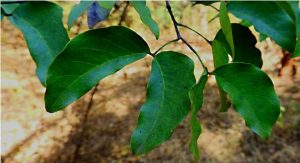
Large sickle shaped leaf false mopane -Guibourtia coleosperma
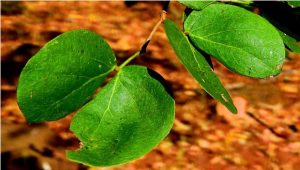
Small round leaf false mopane – Guibourtia conjugata
Guibourtia coleosperma. Large false mopane have sickle shaped leaflets with short stalks. (Right)
Guibourtia conjugata. Small false mopane leaflets are more rounded and do not have petioles (leaflet stalks).
Trees with trifoliolate leaves are fairly common in and around Harare. We saw: Several Searsia (New name for Rhus) being S. lancea, S. natalensis and S. pentheri. Erythrina livingstoniana, Aloe coral-tree and Erythrina lysistemon. Sacred coral tree which we often call the small lucky bean trees (Large lucky bean trees are the Trichilias). Of interest is an Erythrina latissima. Broad-leaved coral-tree we came across whilst carrying out the tree labelling exercise. Just visible now that some of the undergrowth has been removed. Teclea nobilis. Giant cherry-orange has also changed its name, it is now Vepris nobilis. I don’t know what the giant bit is as the fruit is pretty small as far as I’m concerned!
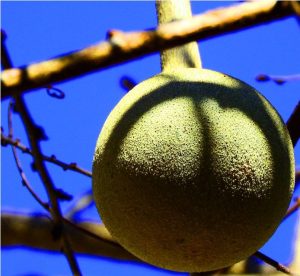
Cladostemon kirkii – Tonga-kerrie or Knob kerrie bush
And the highlight of the day for me was seeing a Cladostemon kirkii. Three-finger bush with a single fruit on it. In South Africa it’s known as the Tonga-kerrie. The fruit looks like a Knob Kerrie and it’s fairly big! There were several small trees all without leaves, but there were a few root shoots displaying the trifoliolate leaves.
NATIONAL BOTANICAL GARDEN – 3rd JUNE 2023
By Tony Alegria, Photo by Jim Drybugh
Cool at first becoming rather hot later and so was that day in June – definitely too warm for this time of the year although I’m not complaining! Only nine of us came along with the three ladies being Meg Coates Palgrave, Dawn Siemers and Ann Sinclair. The guys were: Charles Crawshaw, Jan van Bel, Jim Dryburgh, Mark Hyde, Rob Kelly and myself. The plan for the day was to continue looking at trees with twice pinnate leaves that were not Acacias.
The first tree we looked at was an Albizia harveyi. Sickle-leaved albizia which is very similar to the Albizia amara but has fewer pinnae and has the tips of the small leaflets as per its common name – sickle shaped. This tree has leaves with such small leaflets it could easily be mistaken for an Acacia, but of course it doesn’t have the thorns so are known as false thorn. At this point Meg stated that all albizias have a gland on their petiole, so of course we looked for the gland which we found were more obvious in some albizias than others. Then followed Albizia anthelmintica. Worm-cure Albizia and Albizia zimmermannii. Woodland long-pod albizia. We then came across an unknown Albizia which had a rather thick rachis. A sample was gathered for later identification in the Herbarium. Near the Herbarium is a very large Albizia schimperiana.
Incidentally, the Herbarium is much used by Mark and Meg to either confirm their findings or to identify unknown species of plants and trees. The Tree Society has the Herbarium fumigated twice a year to reduce the number of insects that like eating very dead leaves!
In the ornamental section we first looked at a couple of Radermachera indica. Chinese doll that were growing side by side, one of which had some flowers which were white with long tubes. Of interest was the fact that the leaf was once pinnate at the end but twice and even tri-pinnate just after the petiole. This structure also appears on the Syringa and some other exotic trees. Then we looked at the Colvillea racemosa. Colville’s glory from Madagascar which was coming to the end of the flowering stage with a few remaining orange flowers still to be seen.
Two Delonix species, from Madagascar, were growing fairly close to each other Delonix regia. Flamboyant and Delonix adansonioides [Note from Mark:– now called Delonix decaryi].with its swollen trunk. However there appeared to be another subspecies of Delonix adansonioides with peeling bark growing on a small anthill. [Note from Mark:- named later tentatively as Delonix leucantha].
The Peltophorum dubium had a canopy like an umbrella and the leaflets were rather shiny, unlike our Peltophorum africanum. African weeping-wattle which has rather dull looking leaves.
The Enterolobium contortisiliquum. Pacara ear-pod tree with its very weird looking very dark pods shaped like ears never ceases to amaze.
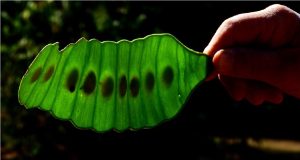
The unmistakeable Entada abyssinica with split seed capsules
The only climber we saw with twice-pinnate leaves was the Pterolobium stellatum. Red-wing which has two small prickles along the rachis below each pair of pinnae and a straight one on top.
After losing some of our members, we went to look at the Entada abyssinica which had very few leaves left but did have some very green looking fruit – these pods are rather large and cannot be mistaken for anything else as they have “split lines” where each seed with its share of the wing can fall off.
On the way back to our vehicles we examined a tree with simple leaves that has now become a very threatened species because of its medicinal properties – Warburgia salutaris.
MAFUNGAUTSI TREE SOCIETY WEEKEND OUTING DAY 1 & 2
15th – 18th April 2023 by Tony Alegria
On the afternoon of the day we arrived, Mark, Jan, Ryan and I stayed back at Pumba Safaris to list the trees at the accommodation site whilst most of the other members took off to see Sengwa Dam that supplies Gokwe with water. Rob and his wife Sheila went elsewhere to get a puncture fixed.
There are many trees at the site including terminalia which were either Terminalia sericea or Terminalia brachystemma – the debate of which-was-which or were they the same would go on for a couple of days. On arrival at Pumba Safaris, Cathy Sharp had been excited at having seen what she thought was a Diospyros batocana. However, during our afternoon of botanizing we found more of these trees and finally found one with fruit – the Diospyros batocana turned out to be Diospyros kirkii!
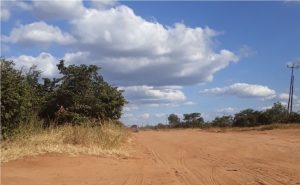
The road south from Gokwe on the Kalahari sands
The next day was Sunday 16th, and we began by picking up two guides from the Forestry Office and then drove south into the Kalahari Sand Forest. After about 1 km beyond the one and only one set of traffic lights we were on a wide dirt road where it was often best to drive in the ditch on either side of the road as it was a lot smoother.
The first stop was a dry waterfall which dropped into a deep gorge. We were surrounded by the people who lived there, and we were offered bush fruit to sample, these were from the Vangueria infausta. Within the gorge and on both sides of the waterfall were many species of trees and shrubs. Some of us descended into the gorge and the rest wandered about on both sides looking for different species of trees and shrubs.
The area had a lot of botanical interest. Meg was presented with many specimens to identify which kept her rather busy – she was our sitting down guru! Even Mark consulted the guru on many occasions, sometimes to seek confirmation on a species and at other times because he too was baffled. Here we found: Euclea schimperi and E. divinorum; Psydrax livida which wasn’t hairy and looked rather different from what we see around Harare, Pavetta schumanniana which also looked different to what we are used to, so perhaps it was something else!
We then proceeded onto the forest area, the dirt road being the boundary between the forest and the local people. As soon as we entered the forest, Mark got very excited about something and we had to stop rather suddenly, he had spotted something special – Paropsia brazzeana. After photos had been taken and we had looked around at the trees and vegetation, we moved on! Strangely enough Paropsia brazzeana was seen all over the place in the Kalahari sands. We then moved forward until someone spotted something of interest and all six vehicles came to a stop and botanizing took place. At almost every stop, some specimens were collected by a few of us – Rob Kelly was an avid collector! And so we moved on deeper and deeper into the forest. At one point we had to make a small diversion around an obstacle which necessitated sawing off a branch and a stump. At other times someone had to hold a branch out of the way whilst all the vehicles passed by.
On one of the many stops I found a small tree with three veined elliptical leaves with a sharp point – it was my first Strychnos pungens! Later on the fruit was seen on bigger trees – monkey oranges with a really weird looking greeny-blue colour. We also came across a couple of trees that were new to me but very much at home on the Kalahari sands, one was the Bauhinia macrantha which is similar to the Bauhinia petersiana but a bit more like a tree and has slightly different flowers. A very common tree was the Baphia massaiensis, Sand camwood, as well as the Baikiaea plurijuga. Zambezi teak. We also came across quite a few Schinziophyton rautanenii. Manketti trees with yellowing leaves which were already dropping off, their jizz just made them stand out amongst all the other trees!
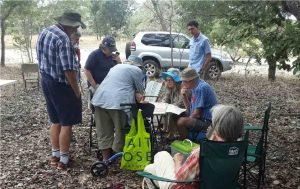
Lunch time discussions
All 20 of us (including the 2 guides) sat around in a big circle for lunch. During this time, Peter Morris took out his maps and selected a route for us to follow. Thereafter we proceeded further along into the forest and later on returned to the main dirt road via a different route.
On the way back to our accommodation, most of us went to the dam to look at a strange acacia that had been seen the day before. Of course there was a lot of other stuff to look at too! More specimens were collected from the acacia which had different sized thorns and rather thick slightly curved pods. Hopefully Meg and Mark will be able to identify this acacia at the National Herbarium.
There were a few Ormocarpum kirkii. Curled caterpillar-pod at the dam as well as in and around Pumba Safaris – the first plants we came across were behind Room 1. At the dam I collected the pods of the Maerua angolensis and on the way back from the dam we found several bushes/trees of interest: A Commiphora sp. with no leaves at all but had spines; a Pterocarpus rotundifolius martinii which has many leaflets: Asparagus laricinus which looked more like a cat’s tail then the wild asparagus we see around Harare.
Every evening before, during and after dinner, Mark and Meg went through the specimens to confirm identities or to press doubtful specimens as well as unknown ones for later confirmation or identification at the Herbarium. During this time I was amazed to see how many ladies were drinking bombers (beer in big bottles!) along with the guys! I think Meg was the ringleader! After all the running around during the day some of us enjoyed an early night!
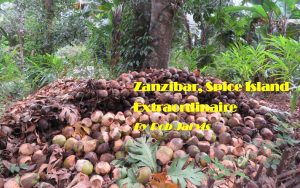
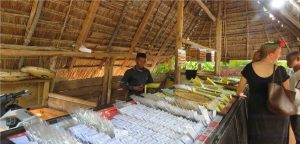
Zanzibar market
What a treat to visit Zanzibar recently and do the usual tourist things like visiting a spice farm. There were untold riches in plant life, growing vigorously and very healthily in mixed populations of ground plants, shrubs, vines, trees and towering palms. Zanzibar is fully tropical and obviously more or less at sea level so the days are balmy, rain can come frequently throughout the year and the spice trade flourishes. Above we see the chopped coconut shells of green fruits, lopped at the narrow end so visitors can sup the milk. Nutritious it is indeed. Below is the charming seed of nutmeg exposed to the light, showing the net-like red aril and the seed within.
Picture 13 then Picture 14 & 15 left & right
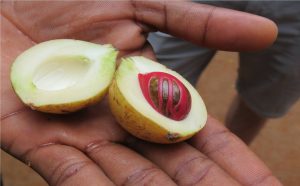
Nutmeg fruit and nut
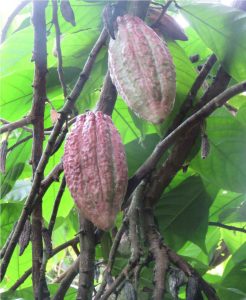
Cacao fruit
Large pods in some trees gave the game away as we all recognised cacao or cocoa. A fascinating tree that produces culinary products with a wide range of uses. The seeds are 50% oil and this is separated to make butter, used extensively.
The solids are powdered down to make cacao which is used to make chocolate. The taste of chocolate only comes after the seeds are fermented and roasted.
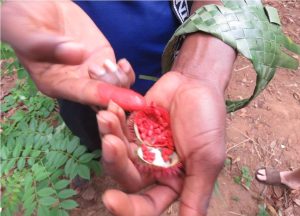
Annatto Bixa orellana – lipstick plant
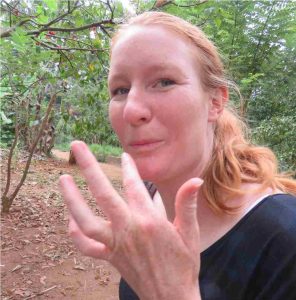
Application of bixa to the face!
The lipstick plant seen on the right, when the pods are opened up the fresh seeds are covered with a red waxy substance that makes a perfect substitute for synthetic lipsticks.
We were fortunate to have a daughter on hand to showcase the application and alluring nature of lip-stick, Zanzibari-style.
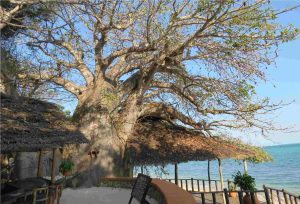
The dhow bar and baobab at Fomba Sea Lodge, Zanzibar
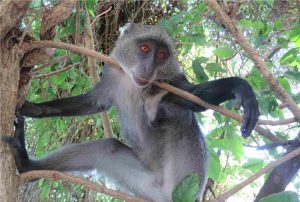
One of the famous Blue Monkeys of Zanzibar
The hotel we stayed at for most of the trip was the famous Fomba Sea Lodge. It is graced with a dhow bar built right underneath a huge baobab on the seashore. A deck has been built up in the main tree canopy and there is a lower deck with one wall just solid baobab. Every evening bushbabies come down to a feeding station on the wall of the tree and visitors can watch them run off with fruity spoils.
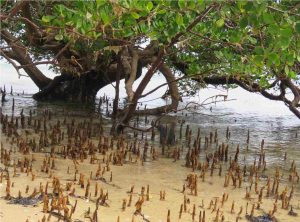
Mangrove roots sticking out of the sand
Just up the coast a little way was this magnificent mangrove, complete with the roots sticking up around the base of the tree that allow it to continue to breathe and respire when the tide is in.
Worldwide there are 80 species or so of mangroves and they perform the same function, stabilizing coastlines and filtering out fine sediments.
Only if you are 100 percent ape-like in your genetics can you truly appreciate trees. The Blue monkeys of Zanzibar are no exception and every day without fail a marauding band of them sweeps through the hotel grounds, bar, dining room, bedrooms and adjoining forest to pick delicacies at will. Interestingly the gang at Fomba have been adopted by a much larger female Red Colobus monkey and she plays nursemaid to the young Blue monkeys while their actual parents wreak havoc.
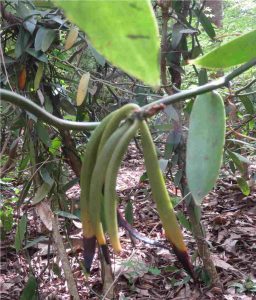
Vanilla bean pods
One of the most precious spices is undoubtedly vanilla (left) and this is produced in the bean-like pods of the vanilla orchid. They thrive in the hot humid conditions of Zanzibar.
TREE SOCIETY COMMITTEE AND CONTACTS
Chairman Tony Alegria tonyalegria47@gmail.com 0772 438 697
Vice Chairman Rob Jarvis bo.hoom52@yahoo.com 0783 383 214
Honorary Treasurer Bill Clarke wrc@mweb.co.zw 0772 252 720
Projects Jan van Bel jan_vanbel@yahoo.com 0772 440 287
Venue Organiser Ann Sinclair jimandannsincs@zol.co.zw 0772 433 125
Tree of the Month Ryan Truscott ryan.kerr.truscott@gmail.com 0772 354 144
Secretary Teig Howson teig.howson@gmail.com 0772 256 364
Tree Society Website https://treesociety.org.zw/
Tree Society Facebook https://www.facebook.com/groups/ztreesociety/
Flora of Zimbabwe: https://www.zimbabweflora.co.zw/
Flora of Tropical Africa: https://plants.jstor.org/collection/FLOTA
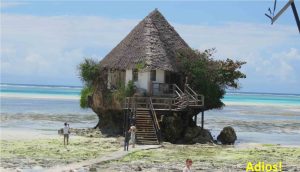
Adios!



